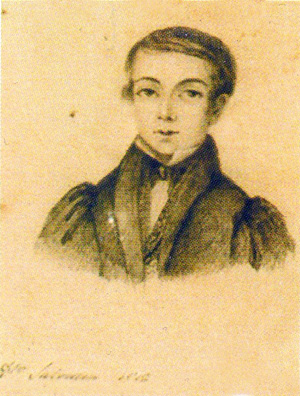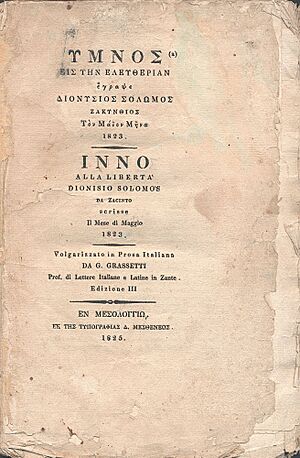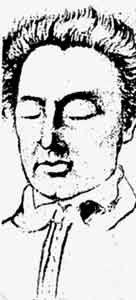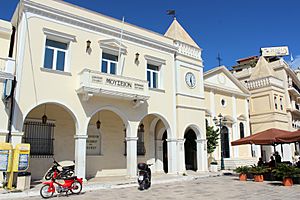Dionysios Solomos facts for kids
Quick facts for kids
Dionysios Solomos
|
|
|---|---|
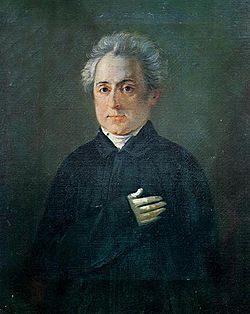 |
|
| Native name |
Διονύσιος Σολωμός
|
| Born | 8 April 1798 Zakynthos, Ionian Sea (modern-day Greece) |
| Died | 9 February 1857 (aged 58) Kerkyra, United States of the Ionian Islands (modern-day Greece) |
| Occupation | Poet |
| Language | Greek, Italian |
| Nationality | Greek |
| Education | University of Pavia (LL.B., 1817) |
| Notable awards | Gold Cross of the Redeemer 1849 |
| Signature | |

Dionysios Solomos (born April 8, 1798 – died February 9, 1857) was a famous Greek poet from the island of Zakynthos. He is known as Greece's national poet. His most famous work is the Hymn to Liberty (Ýmnos eis tīn Eleutherían). This poem was put to music by Nikolaos Mantzaros and became the national anthem of Greece in 1865. It also became the national anthem of Cyprus in 1966.
Solomos was a key figure in the Heptanese School of poetry. He is considered the national poet not just for the anthem, but also because he helped keep old Greek poetry traditions alive. He showed how these traditions could be used in modern writing. Other important poems he wrote include The Cretan and The Free Besieged. It's interesting that most of his poems, except the Hymn to Liberty, were never finished. Also, almost none of his work was published while he was alive.
Contents
Life of Dionysios Solomos
Early Life and Education
Dionysios Solomos was born on Zakynthos in 1798. His father was a rich count named Nikolaos Solomos. His mother was Angeliki Nikli, who worked for his father. Nikolaos Solomos' family came from Crete. They moved to Zakynthos in 1670 after the Ottoman Empire took over Crete.
Dionysios' father married his mother the day before he died in 1807. This made young Dionysios a legal heir to his father's property. He spent his childhood on Zakynthos. An Italian tutor, abbot Santo Rossi, taught him. In 1808, after his father passed away, Dionysios was sent to Italy to study law. This was common for noble families from the Ionian Islands.
Studying in Italy
Solomos went to Italy with his tutor. He first went to a school in Venice. But he found the rules there too strict. So, his tutor took him to Cremona, where he finished high school in 1815. In November 1815, Solomos started studying law at Pavia University. He graduated in 1817.
He loved Italian literature and spoke Italian perfectly. So, he started writing poems in Italian. Some of his first important Italian poems were Ode to the first mass and The destruction of Jerusalem. He met famous Italian poets and writers, including Ugo Foscolo from Zakynthos. He became a respected poet in Italian literary groups.
Returning to Zakynthos
After 10 years of studying, Solomos came back to Zakynthos in 1818. He had a strong background in literature. Zakynthos was known for its lively literary scene. There, he met many people who loved literature. Friends like Antonios Matesis and Georgios Tertsetis would gather at each other's homes. They enjoyed writing poems together. They often made up poems on the spot, using a given rhyme or topic.
His Italian poems from this time were published in 1822. The collection was called Rime Improvvisate.
First Greek Works and Meeting Spyridon Trikoupis
While writing Italian poems, Solomos also started trying to write in Greek. This was hard for him. He had studied classical languages and Italian, but not much Greek. Also, there weren't many good examples of poetry written in the everyday Greek language (Demotic Greek) at that time.
However, because his Greek education was minimal, he wasn't influenced by the "purist" Greek language (katharevousa). Instead, he wrote in the language spoken by ordinary people on his island. To improve his Greek, he studied folk songs and older Greek literature. This helped him create some of the first major works in the everyday Greek language. Poems from this time include The little blond girl and The mad mother.
A very important moment for Solomos was meeting Spyridon Trikoupis in 1822. Trikoupis visited Zakynthos and wanted to meet Solomos because of his growing fame. During their second meeting, Solomos read his Ode to the first mass. Trikoupis was impressed. He told Solomos that his Greek wasn't fluent, but encouraged him to write in Greek. Trikoupis said, "The Greek Parnassus does not yet have its Dante."
The Hymn to Liberty and Growing Fame
The Hymn to Liberty was a major turning point in Solomos' Greek writing. He finished it in May 1823. The poem was inspired by the Greek War of Independence that started in 1821. It was first published in 1824 in Mesolongi. Later, it was translated into French and other languages, making Solomos famous outside Greece.
This poem made Solomos respected until his death. Most of his other works were only known by a small group of friends and students. The Hymn to Liberty helped Solomos master the Greek language. He started trying more complex forms of poetry. This period also saw him write Ode to the death of Lord Byron and Psara's Destruction. He also wrote The Dialogue (about the Greek language) and The Woman of Zakynthos.
It is said that Solomos could hear the cannons firing from Zakynthos during the Greek War of Independence. This inspired him to write his most famous works.
Moving to Corfu
After some family disagreements about inheritance, Solomos moved to Corfu. Corfu was a major center for thinkers and artists in the Ionian islands at that time. Solomos had planned to move there since 1825. Corfu offered him a more inspiring environment and the quiet he needed for his unique personality. It was a perfect place for thinking and writing poetry.
During his first years in Corfu, he was very happy. He started studying German romantic philosophy and poetry. He read works by thinkers like Hegel and Goethe through Italian translations. He also continued working on The Woman of Zakynthos and Lambros, which he had started in 1826.
Important Works of His Later Years
Between 1833 and 1838, Solomos faced more family disagreements. His half-brother claimed part of their father's inheritance. Even though Solomos won the case, the dispute upset him. It made him withdraw from public life.
Despite these problems, he continued his poetic work. The period after 1833 is considered the mature phase of his poetry. This led to his unfinished but powerful poems: The Cretan (1833), The Free Besieged (until 1845), and O Porfyras (1847). These are thought to be his best works. He also planned other works that remained as fragments, like Nikoforos Vryennios.
The Corfu Circle
In Corfu, Solomos quickly became the center of attention for poets and admirers. This group included educated thinkers with modern ideas and a strong interest in art. Key people he met were Nikolaos Mantzaros, Niccolò Tommaseo, and Iakovos Polylas.
Polylas, Ioulios Typaldos, and Gerasimos Markoras were Solomos' students. They formed a group known as the "solomian poets." This group marked a golden age for Greek poetry, long before the "New Athenian School" appeared.
Last Years and Death

After 1847, Solomos started writing in Italian again. Most of his works from this time were unfinished poems and notes. He might have planned to translate them into Greek. In 1851, he began to have serious health problems. His personality became even more difficult. He stopped seeing some friends, though he later made up with Polylas in 1854. After his third stroke, he stayed home.
Solomos died in February 1857 from a stroke. He was so famous that everyone mourned his death. The theater in Corfu closed, and the Ionian Parliament stopped its meetings. His remains were moved to Zakynthos in 1865.
Works of Dionysios Solomos
Literary Influences and Major Works
Solomos' early poems were influenced by Italian poetry and early romanticism. He was greatly influenced by European romanticism, including poets like Lord Byron and Giacomo Leopardi. The years 1823–1833 were very important for his development as a poet. During this time, he moved away from simple improvisation and older styles.
Solomos was also influenced by the ideas of the Enlightenment and the French Revolution. He supported Italian efforts for freedom and unity.
In 1823, he wrote the epic Hymn to Liberty. The first two parts of this poem became the Greek national anthem. It celebrates the Greek War of Independence (1821). The poem shows Liberty as a person, rising from the "sacred bones of the Greeks." It mentions other countries, like America, and criticizes Austria. Solomos also talks about his own Ionian islands, which were under British rule. He describes them as "artfully chained." The poem doesn't hide the harshness of war. It ends by urging revolutionaries to stay united and avoid civil war.
In 1824, Solomos wrote The Dialogue. This work discusses the issue of language. It features a poet, his friend, and a scholar. The poet argues that katharevousa (a purist Greek language) is artificial. He says it's not useful for people or literature. He supports a literary language based on the everyday language spoken by people. He believes poets should refine this language. He famously said, "firstly succumb to the language of the people and then, if you are worthy, conquer it."
Between 1826 and 1829, Solomos worked on The Woman of Zakynthos. This is a satirical poem that explores the idea of Evil. The story is told by a monk named Dionysios. "The Woman" represents evil. It's believed this poem was about one of Solomos' relatives. Because of this, his brother never allowed it to be published by Iakovos Polylas.
In 1833, Solomos wrote The Cretan. This was his first important work from his mature period. It's written in a 15-syllable verse, influenced by Cretan literature. The poem tells the story of a Cretan man who left Crete after a revolution failed in 1826. It describes a shipwreck and his efforts to save his beloved from a storm. A key part of the poem is the appearance of a mysterious figure, the Feggarontymeni (meaning "the one dressed by the moon"). The Cretan himself tells the story. He looks back at his life in Crete and the shipwreck. He also talks about the future, like meeting his beloved in Paradise. The Cretan is considered a very complete poem in its beauty. It mixes images of storms with the pursuit by the Turks. Scholars still discuss who the Feggarontymeni represents. Some think she is a symbol of the Virgin Mary, the Motherland, or his dying fiancée.
Between 1833 and 1844, Solomos worked on The Free Besieged. This poem was inspired by the Third Siege of Missolonghi and the brave escape of its people. It describes the last days of the siege, when food ran out and the city was sure to fall. Solomos' notes in Italian are helpful for understanding the poem. The main idea of the poem is willpower and fighting against nature's temptations. There are three unfinished versions of this work. Even though they are fragments, they are considered some of the best modern Greek poetry. Many Greek poets look up to Solomos as a superior poet.
His last major work was "O Pórfyras" (The Shark), written in 1847. This poem was inspired by a real event: a shark attacked an English soldier swimming in Corfu harbor. Porfyras is hard to understand because it's fragmented. It also explores the relationship between nature and humans, and the body and soul.
The unfinished poems Lampros and Porfyras show Solomos' romantic side. They have themes of sadness, mystery, and the supernatural. He was influenced by both Byron and Leopardi.
The poem Ode to the death of Lord Byron is a lyrical poem. It was written after Byron died during the siege of Mesolongi. Its subject and style are epic.
Smaller Works and Translations
Solomos also translated Italian poetry. He translated Desdemona's song from Shakespeare's Othello. He wrote short poems, other verses, and funny satirical poems in the Zakynthian dialect. He also wrote two prose works, including the sad and mystical The Woman of Zakynthos. Only a few lines remain from his attempts to translate parts of the Iliad into modern Greek.
How His Work Was Received
From the start, Solomos was important in the literary groups of Zakynthos. After the Hymn to Liberty was published, his fame spread across Greece. On the Ionian Islands and in Athens, people knew him mainly from his published poems. These included the Hymn to Liberty, parts of Maria's prayer, Lampros, and Ode to the Nun. Many of his poems were shared by word of mouth or set to music.
Leading writers of the First Athenian School admired Solomos' works. They had some concerns about the language he used. In 1827, Iakovos Rizos Neroulos wrote that Solomos' poems had "a strong and fascinating inspiration." Alexandros Soutsos called Solomos "a great maker of odes." Alexandros Rizos Ragkavis said Solomos' spirit made him "one of Greece's greatest glories." Even before his death, Solomos' poetry was linked to the idea of the homeland. In 1849, a newspaper wrote that "the poetry of Solomos is not the poetry of a single person but the poetry of a whole nation."
After Solomos died, similar praise continued. The magazine Pandora called him "one of the finest poets of Greece and of Europe." His students, like Ioulios Typaldos and Iakovos Polylas, gave speeches praising him. Polylas called him "the national poet" in 1859.
However, when his unfinished works were finally published in 1859, it was a surprise. Newspapers that had praised him before didn't say much about the publication. Some writers, like Valaoritis, felt that "the nation's hopes were deceived" because so much was incomplete.
People started to re-evaluate Solomos' work after 1880. This was especially true after Kostis Palamas wrote about him. Palamas recognized the historical importance of Solomos' work. He noted how Solomos created his own poetic language. He also combined elements of old poetic traditions with European ideas.
The Unfinished Nature of His Works
One of the most important things about Solomos' poetry is that most of it is unfinished. The only works published during his lifetime were the Hymn to Liberty (1825), a part of Lampros (1834), the Ode to the Nun (1829), and a short poem To Francisca Fraser (1849). The rest of his works remained incomplete. Solomos was always trying to make his poems perfect. He wanted to remove anything extra that took away from their main lyrical feeling.
His handwritten notes show all the stages of his writing. They don't have a final version. He often started with an Italian prose draft. Then he would work on the Greek version. Many lines exist in different versions, sometimes out of order or with gaps. He even wrote verses from different poems on the same piece of paper. For example, The Cretan (1833) is very fragmented. This adds to the feeling of pain in the poem, as the speaker is a beggar whose life has been destroyed.
Iakovos Polylas, a loyal student of Solomos, faced many challenges when he published his teacher's work. He had to get permission from Solomos' brother. Then, he had to organize the scattered notes, which were hard to read. He tried to put together a complete and clear work. Polylas chose the verses he thought best matched what Solomos intended. Sometimes, he added verses he had heard Solomos recite. In 1859, Polylas published Solomos' work as "Apanta ta Evriskomena" (Omnibus of the works found). He included a great introduction. In it, he said that the final versions of the poems were lost.
Understanding the Unfinished Works
When Solomos' work was first published, its unfinished form disappointed many. People didn't fully understand its value then. Polylas suggested that the main manuscripts of the final poems were lost or destroyed. Some thought Solomos' servant or brother might have stolen them. Others thought Solomos himself destroyed them. It wasn't until the early 20th century that it became clear no more manuscripts existed. It was understood that Solomos simply hadn't finished his poems.
Early ideas about why his work was unfinished often looked outside the texts themselves. Some thought it was because there wasn't a good intellectual environment to motivate him. Or maybe there wasn't a strong literary tradition for him to follow. Others blamed psychological reasons, like a lack of ability to finish works, the negative effects of his family disagreements, his desire for perfection, or his feeling of never being satisfied.
However, some scholars pointed out that Solomos might not have cared about finishing his poems. A famous quote attributed to him says, "Lampros will remain an abstract, because the whole poem does not reach the height of some days." Linos Politis noted about The Free Besieged that Solomos "did not want or did not care to incorporate these lyrical pieces into a narrative group." He focused on pure, lyrical expression. Later, Solomos was seen as a pioneer of "pure poetry." The fragmented nature of his work was no longer a problem; instead, it was seen as a strength.
In recent years, some have tried to link Solomos' unfinished works to other fragmented works in romantic literature. Examples include Kubla Khan by Coleridge and Giaour by Lord Byron. However, not all scholars agree with this idea.
Publication Challenges
From 1920 to 1930, there was a discussion about publishing works not included in Iakovos Polylas' edition. These included The Woman of Zakynthos and satirical poems. The Academy of Athens decided to publish Solomos' poems with a critical edition. This led to a debate about whether to publish a "genuine" edition (showing all his notes) or a "critical" edition (a more finished version). The critical edition was never published. Instead, scholars prepared "easy to use" editions for more readers.
In 1964, Linos Politis published Solomos' manuscripts using photos and typed copies. This was a major step in studying Solomos' works. It showed how the poet worked. Scholars could now study all his editing stages and suggest new editions.
Today, attempts to edit Solomos' work fall into two groups. The "analytical" edition shows all the different writing stages and versions of each poem. The "synthetical" edition presents the work in a logical order, trying to make it complete. It leaves out verses or parts that don't fit these goals. An example of a "synthetical" edition is Stylianos Alexiou's (1994), which was criticized by those who preferred the "analytical" approach.
Surviving Works at His Death
When Dionysios Solomos died, most of his work was unfinished and in fragments. His friend and fellow poet Iakovos Polylas edited and published what he found. It's not clear why so much was unfinished. Maybe Solomos was never happy with his work. Or perhaps many of his notes were lost, as Polylas suggested. Or maybe he found it hard to complete the big plans he had for his poems.
The fragments show a big difference between what he wanted to do and what survived. For example, The Cretan starts with a piece of Canto 18 and ends with Canto 22, and none of them are complete. Lambros was planned to have at least 38 cantos, but only summaries or short poetic pieces remain. The second version of The Free Besieged has 61 fragments. Many of these are just one or two lines long.
Legacy of Solomos

Solomos is often called Greece's "national poet." This is because of his important contribution to Greek literature and national identity.
The Museum of Solomos and Eminent Zakynthians opened in 1959 in Zakynthos city. It highlights Solomos and another poet, Andreas Kalvos. Solomos' remains have been in the museum's mausoleum since 1968.
His image was on the back of the Greek ₯20 coin from 1990 to 2001. A special 50 drachmas coin was made in 1998 to celebrate 200 years since his birth.
The Zakynthos International Airport and a square in Nicosia, Cyprus, are named after Dionysios Solomos.
The 1998 film Eternity and a Day shows a dying Greek poet trying to finish some of Solomos' incomplete works. The poet also sees visions of Solomos (played by Fabrizio Bentivoglio) as he travels around Thessaloniki.
Works
Greek Poems
His First Works
- To the girl who was brought up in a monastery
- To the small niece's death
- Desire
- Homer's shadow
- Remembrance
- Evrikomi
- To a friend near death
- The orphan's death
- The dream
- The shepherd's death
- The little soul
- To sir Lodovikos Stranis
- To sir Georgios De Rossi
- The Unrecognizable
- The miff
1823–1833: The Period of Formation
- Hymn to Liberty (1823)
- Funerary Ode
- Lyrical poem "To the death of Lord Byron" (1824)
- To a nun (1829)
- To Markos Botsaris (1823)
- The destruction of Psara (1824)
- To the English lady's death
- The poisoned (1826)
- The poisoned in Hades
- Lampros (1829)
Great Works of Maturity
- The Cretan (1833)
- The Free Besieged (1826–1844)
- The Whale (1849)
Last Drafts
- Nikiforos o Vryennios
- To the death of Emilia Rodostamo (1848)
- To Francisca Fraser (1849)
- To the death of his niece
- To the King of Greece
- The Eastern War
- Carmen Seculare
- Greek Mother
Satirical Works
- The New Year's Eve (1824)
- The Doctors' council (1825)
- The dream (1826)
- The Hair (1833)
Translations
- Spring by Metastasio
- Summer by Metastasio
- Petrarca's Ode
Greek Prose
- The Dialogue (1822–1825)
- The Woman of Zakynthos (1826–1829)
Italian Poems (Selection)
Early Works
- Jerusalem's destruction
- Ode to the first mass
- Rime Improvvisate (collection, 1822)
Incomplete Poems of the Last Period
- The Greek little boat
- Sappho
- Orpheus, sonnet
- A sonnet on the death of Stelios Marcoras
- The mystical tree (extract)
- The poisoned (fragments)
- The young warrior (fragments)
Drafts of Poems Written in Prose
- The Greek Mother
- The veiled woman
- The nightingale and the falcon
- Orpheus
- Porfyras
Italian Prose
- For Dr. Spiridione Gripari (funeral speech, 1820)
- Praise of Ugo Foscolo (speech in memory, 1827)
See also
 In Spanish: Dionisios Solomós para niños
In Spanish: Dionisios Solomós para niños


